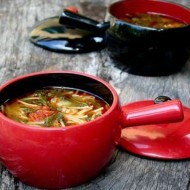What is lagenaria and how to grow it in a summer cottage
Content
Description of Lagenaria
Lagenaria vulgaris is an annual liana of the Pumpkin family. In natural conditions, it lives in Latin America, India, on the African continent. It has long creeping stems, is characterized by rapid growth - in two weeks the lashes can stretch 1.5-2 m. The leaves are 5-sided, corrugated, rough and slightly pubescent.
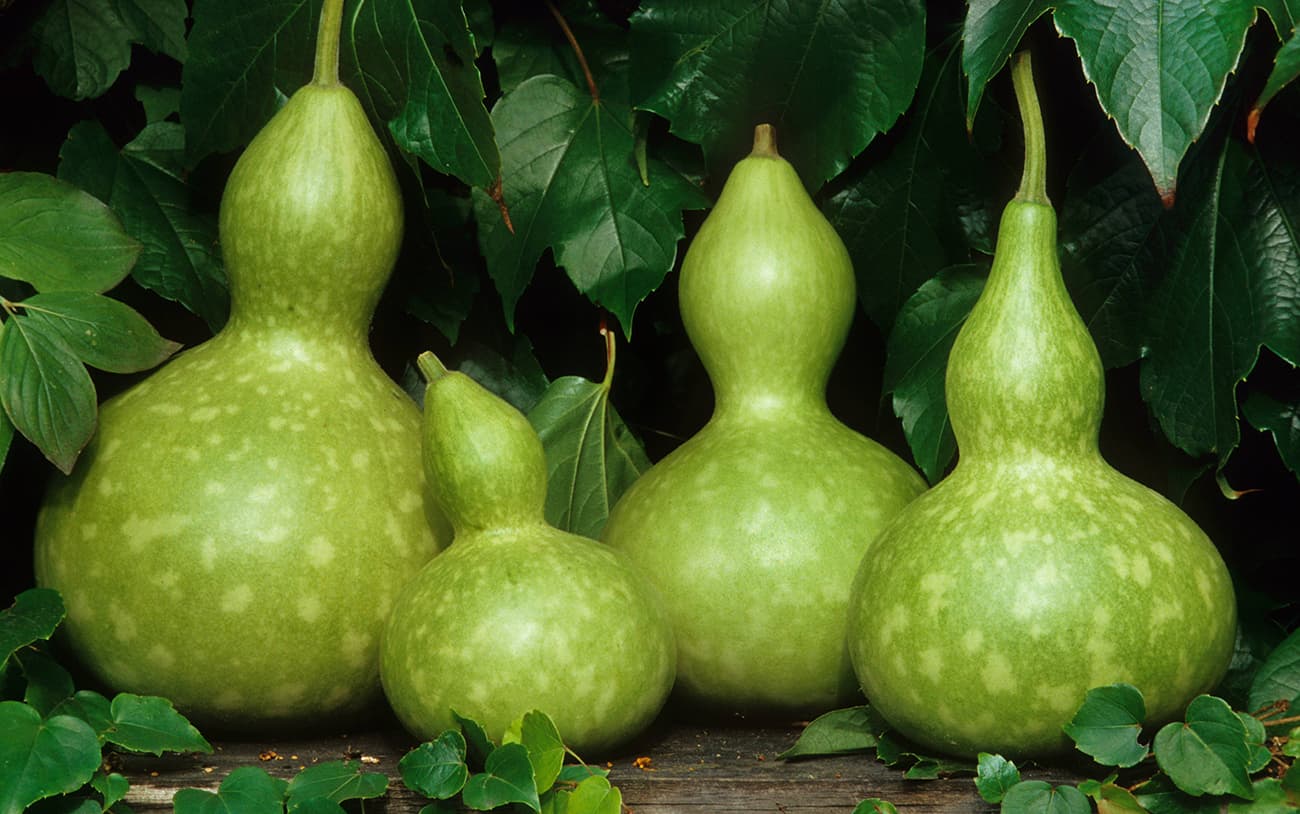
It blooms like a pumpkin, with small tubular flowers of white or cream color, located singly in the axils of the leaves. An interesting feature is that the flowers open and exude aroma only at night, and at dawn they begin to close. Lagenaria fruits are also similar to pumpkins, but are more varied in shape, size and color.
Varieties and types of crops
All varieties and hybrids of Lagenaria are divided into two groups - edible and decorative. Each group has outstanding representatives.
Calabaza
An ornamental variety, surprising in the shape and size of the fruit. Scourges reach 15 m. Fruits are pear-shaped, green in color, reach 45-40 cm in length, however, two-meter pears are not uncommon. It is from such fruits that large vessels and jugs are made.
Bottle
A compact decorative variety. The lashes grow by 3 m, the maximum length of the fruit is 70 cm, the shape resembles a jug, but with a fairly wide upper part. The color of pumpkins is pale green or white.
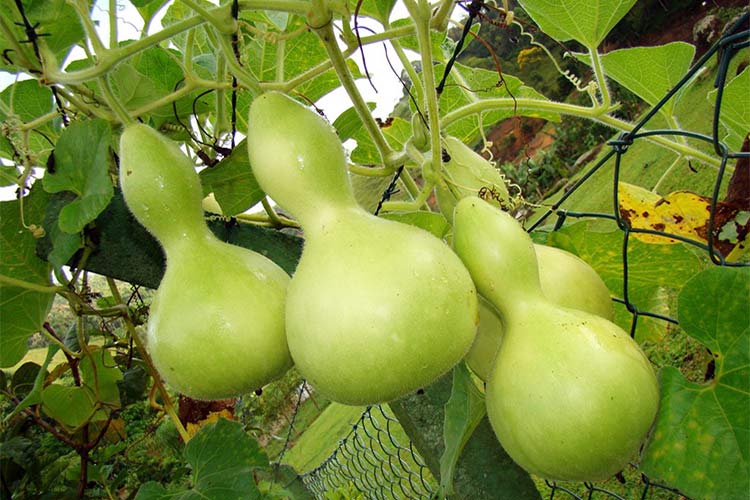
Polenoid
Edible species with fruits similar in appearance and taste to young squash. The bush itself is branched, the leaves are similar to pumpkin leaves, the fruits are large, at full maturity they reach a weight of 10-15 kg, the peel is light.
Serpentine
An amazing variety with very long, light green fruits that curve like a snake. In terms of taste, the serpentine variety is similar to the previous one. However, the fruits themselves are smaller - 5-6 kg with a length of 70 cm.
Cobra
The variety stands out for its unusual mottled color and intricate shape of the fruit, in which there is a noticeable thickening in the lower part, and in the upper part there is a thin curved "neck", like a snake. The fruits have excellent taste.
Goose in apples
Another edible variety that looks very decorative. The fruits are similar in shape to the Cobra, but their "neck" is thinner and more curved. For this feature and spotty color, the variety was named Goose in apples.
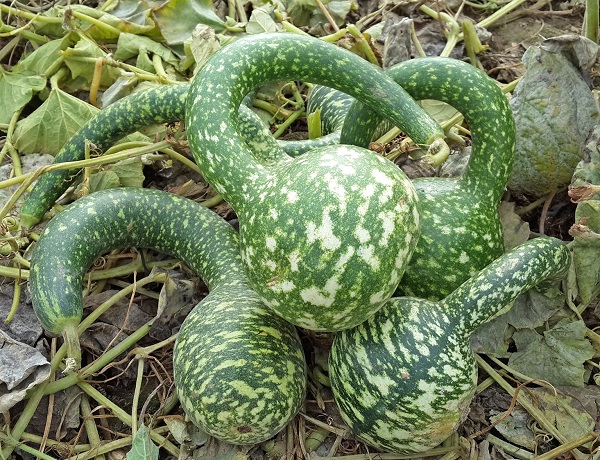
Swan
In appearance, the Swan is similar to the previous variety, only its "neck" is bent to the side and, as it were, raised up. The variety is considered decorative and is not eaten, but long vines are often used in vertical gardening.
Swan geese
Another related "goose" variety.The fruits practically do not differ externally, but the bush is very compact, the length of the whips does not exceed 1.5 m. Ripe pumpkins are used for souvenirs. Young fruits taste good.
Hostess
This variety is characterized by a variety of forms - the fruits can be in the form of pears, cylinders, bottles with a flat and elongated with a thickening in the upper part of the "neck". The color is light salad or green with a spot.
Cylindrical
This variety is something averaged between the Serpentine and Polenovidny variety. The fruits are also long, but even, bright green or salad-colored. When young, their pulp is very tender and tasty.
Warty
Rarely cultivated variety due to low fruit attractiveness. Their color and shape are standard, like those of a squash, but the surface is completely covered with small growths that look like warts.
Club-shaped
The fruits of this lagenaria resemble a mace in shape - they are wide at the bottom, and taper at the top. They grow to an impressive size - about 2 m in length, the color is pale, like a vegetable marrow. The club-shaped variety is cultivated for decorative purposes only.
Turban
The most decorative variety with miniature mushroom-shaped fruits. Pumpkins have a light “stem” and “cap”, which, when fully ripe, takes on a bright orange color.
Video "Description and cultivation of lagenaria"
This video explains what lagenaria is and how to grow it.
Features of planting and growing
The cultivation technology of lagenaria is similar to that of pumpkin or vegetable marrow. In the southern regions, seeds are sown in mid-April. In the middle lane and the Moscow region, the culture is grown through seedlings, which are sown a month before transplanting to the garden.
Seed preparation
Due to the dense shell, seeds germinate for a long time. To speed up this process, they are soaked and artificially helped to open up. First, it is placed in water for 2 days, then laid out on a cloth or sawdust, previously moistened with water with a few drops of a growth stimulator.
At temperatures not lower than +23 ° C, the casing swells in 5-6 days. After that, each seed is cracked with hands and placed again in a humid environment. They are planted in the soil after a few days, when the sprouts hatch.

Planting in the ground or seedlings
For direct planting, shallow holes are dug into the ground at a distance of 1.5-2 m. A little humus and ash are poured there, water is poured, and then 2-3 seeds are laid out in each hole. Then they cover it with earth, and water it again. It is advisable to plant the culture in a sunny, windless place.
Separate small containers should be used for seedlings, since the sprouts do not tolerate the picking well. The substrate is suitable for universal use. Planting is carried out to a depth of 1.5-2 cm. Care consists in regular watering, maintaining the temperature and lighting. The seedlings are moved to the garden bed when the risk of night frosts passes.
Care Tips
There are no special requirements for care. The main activities are watering as the soil dries up, loosening and feeding no more than 2 times during the entire season. When several true leaves appear, complex fertilizers with nitrogen are applied under the bush, during flowering - a potassium-phosphorus complex.
So that the vines do not grow much, they are pinched. For each lash that has reached a length of 1.5-2 m, the top and excess ovaries are broken off, leaving no more than 5-6 fruits on the bush.
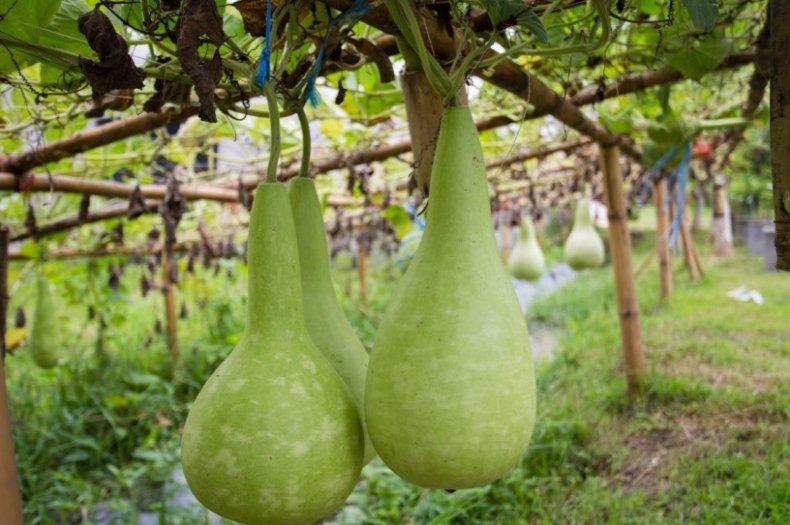
Cooking applications
The main application of lagenria is, of course, cooking. Only young fruits are eaten, since as it ages, the pulp begins to taste bitter. The young vegetable tastes like zucchini, so the recipes are very similar.You can cook warm salads, vegetable stews, omelets, all kinds of casseroles, squash-type caviar, stuffed dishes, and make preparations from the product. We offer a couple of recipes for cooking delicious dishes.
To prepare a casserole, you need the following ingredients:
- 600 g of fruit;
- 200 g sour cream;
- 200 g of hard cheese;
- 2-3 cloves of garlic;
- some butter;
- salt, spices.
Cut the fruits into thin (about 1 cm) rings and blanch in salted water for 5 minutes. Grate cheese, chop garlic and mix with sour cream. Grease a casserole dish, lay the lagenaria in layers, smear with sour cream and sprinkle with cheese so that the top layer is cheese. Bake at 180 ° C until golden brown.
To prepare vegetables stuffed with meat, you need the following ingredients:
- 0.5 kg of long fruits of lagenaria;
- 0.5 kg of minced meat;
- 1-2 carrots;
- 2 medium onions;
- 100 g sour cream;
- 100 g of cheese;
- some vegetable oil;
- salt and pepper to taste.
Cut the lagenaria into pieces 4-5 cm long, cut the middle, dip the blanks in boiling salted water for 3-5 minutes. Stew the grated carrots and chopped onions in vegetable oil until soft. Combine stewed vegetables with meat, add salt, pepper, mix everything and fill the workpiece with minced meat. Cover the form with foil, lay the vegetables tightly to each other, pour with sour cream and sprinkle with grated cheese. Bake until golden brown.
Lagenaria fruits can be cut in parts directly on the bush. The cut will not rot - it will simply dry out, after which the vegetable will continue to grow further.
- Vegetable casserole with minced meat
- Vegetable soup
- Jam from Lagenaria
The use of lagenaria for decorative purposes
The peel of ripe fruit is firm and waterproof. This property allows the use of lagenaria in decorative arts. The inhabitants of Africa, Latin America and the island states have long learned to make kitchen utensils, musical instruments, pipes and even toys from fruits. For decorative purposes, lagenaria is removed as late as possible, just before the frost. To build some kind of craft, the fruit must be well dried, then cut off the top, scoop out the pulp, and decorate the shell with a pattern.
The most common products from Lagenaria are all kinds of vessels, vases, jugs, containers for storing food. The solid surface of pumpkins is easily painted, varnished, you can burn out and create any patterns on it, the main thing is imagination. An unforgettable creative experience is guaranteed.
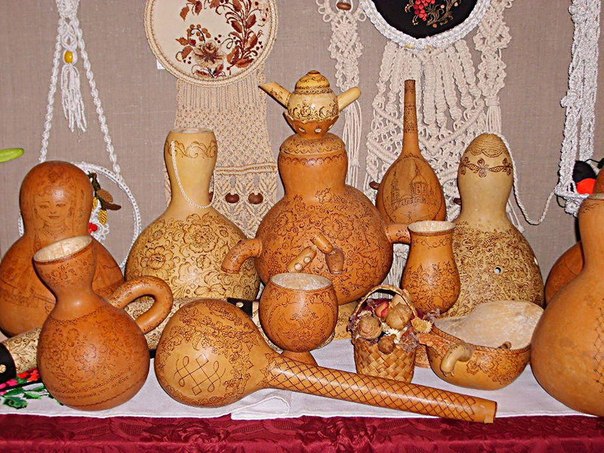
The fast-growing liana can be successfully used to decorate arches and fences. In literally a month, she will braid the structure and create a blessed shadow.
Lagenaria can be considered a unique vegetable crop. Its cultivation does not cause much trouble, and the harvest can be applied in many areas, from cooking to decorative painting. In addition, any housewife will be pleased to receive handmade dishes from natural materials as a gift.


